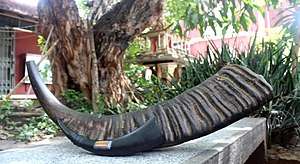Sneng
The Sneng (Khmer: ស្នែង) is a reed aerophone, made from an ox horn or water buffalo horn and producing sound with a single free reed.[1] Two different styles exist. The end-blown instrument has the tip of the horn cut off, with the reed inserted into that end.[2] The tip then functions as the mouthpiece to blow a single note.[2] The side-blown instrument has a hole in the side of the instrument's body, where a bamboo free-reed and a mouthpiece are fastened with wax.[2][1] The reed there can be either blown or sucked to produce a tone. Each end of the instrument has holes that function as fingerholes to change the notes, tuned a fourth apart.[1] The instrument was capable of two or three notes.[1][2] The large hole can be covered with the player's palm, the small hole with a finger or thumb.[2] The instrument is loud enough to call across a distance and has been used in rural environments to signal mealtimes, give warning, call for help or indicate a need to return to the village.[1] It was also used to call domestic elephants in from the field, and hunters communicated with it.[1]
 A side-blown Cambodian musical instrument called a Sneng ស្នែង, made from a cow's horn, sits in front of an end-blown sneng, made from a water buffalo horn. The side-blown instrument's mouthpiece is visible on the side of the horn. | |
| Woodwind instrument | |
|---|---|
| Other names | saamleng sneng |
| Classification | woodwind |
| Hornbostel–Sachs classification | 422.212 (Reed aerophone. The pipe has a single 'reed' consisting of a percussion lamella, with conical bore
|
| Related instruments | |
| |
References
- Sam-Ang, Sam (2008). "The Khmer People of Cambodia". In Miller, Terry E.; Williams, Sean (eds.). The Garland Handbook of Southeast Asian Music. New York: Taylor & Francis. p. 97. ISBN 978-1-234-56789-7.
- Khean, Yun; Dorivan, Keo; Lina, Y; Lenna, Mao. Traditional Musical Instruments of Cambodia (PDF). Kingdom of Cambodia: United Nations Educational, Scientific and Cultural Organization. p. 134.